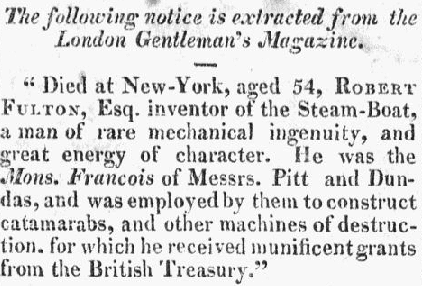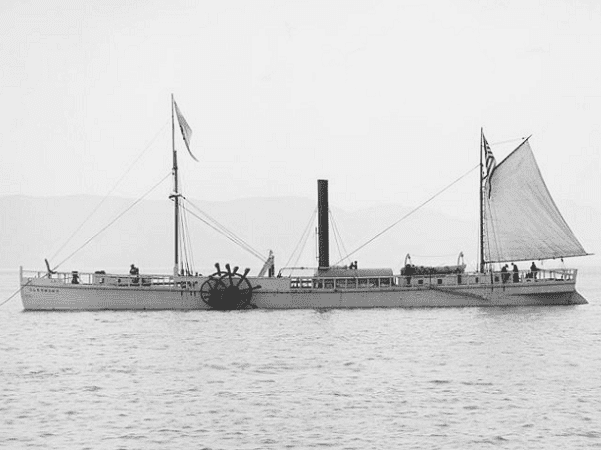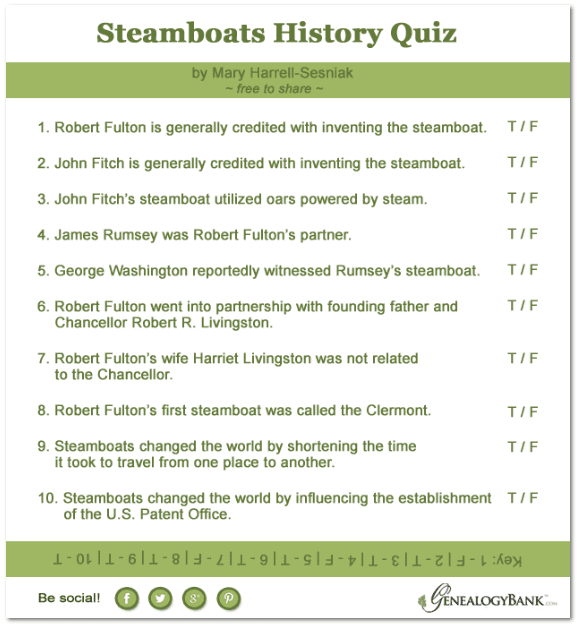Introduction: Mary Harrell-Sesniak is a genealogist, author and editor with a strong technology background. In this guest blog post, Mary uses old newspapers to research the invention of the steamboat—and describes how much steamboats changed our ancestors’ world.
The invention of the steamboat radically changed our ancestors’ world. While researching your ancestors’ lives in historical newspapers, you will run across many mentions of steamboats. This blog article, including a fun quiz, will test your knowledge of the history of steamboats and help fill in some of the gaps for you.
Who Invented the Steamboat?
Although many, including the writer of this 1815 obituary, credit Robert Fulton (1765-1815) as the steamboat inventor, it simply isn’t true. So if Robert Fulton wasn’t responsible, who created the first steamboat?

Perhaps you are an expert in steamboats; test your knowledge with this handy steamboat quiz and check your answers below.
John Fitch
Most historians attribute the honor John Fitch (1743-1798) as the inventor of the steamboat, who constructed the first steamboat in the United States.
As you can see from this 1786 announcement addressed “To the ENCOURAGERS of USEFUL ARTS,” Fitch “proposed a Machine for the improvement of Navigation” which was endorsed by a number of subscribers who thought that “it might be beneficial to the public.”
Several state legislatures granted Fitch a 14-year monopoly on all steamboat travel on the inland waterways within their borders. This steamboat monopoly in turn helped him attract investors. His invention used steam to power oars, and in 1788 his commercial steamboat could carry up to 30 paying passengers per trip on the Delaware River. (See Wikipedia’s image of a woodcut by James Trenchard showing Fitch’s steamboat.)
James Rumsey (or Rumsy), Fitch’s Rival
As is the case with many inventions, other inventors of the steamboats worked on the concept of steam navigation simultaneously, including James Rumsey (1743-1792). His steamboat incorporated steam propulsion and was patented by several southern states.
After Rumsey went to Philadelphia in 1788 a pamphlet war arose with Fitch, with each claiming the right to make steamboats. This 1910 newspaper article reported that:
“George Washington had written a letter certifying that he had witnessed trials of the Rumsey boat, and that although he formerly had but little faith in it, he was then convinced that Rumsey had discovered the art of working boats by mechanism.”
This article also reported that Rumsey “had a controversy before his death with Fitch, whom he accused of ‘coming pottering around’ his shop.”
Several people tried in vain to get the two inventors to work together. It is reported that Fitch tried to secure a patent in England based upon Rumsey’s water-tube boiler. There was even a Rumseian Society formed in 1788 to assist Rumsey, but it was disbanded in 1792 after his death. I recommend you read about it on the Web and at http://jamesrumsey.org/. It is a very interesting story.
Robert Fulton
Although Fitch and Rumsey preceded Robert Fulton with their steamboat inventions, Fulton’s contributions to commercial steamboat operations should not be overlooked.
In 1801, he and partner Chancellor Robert Livingston (1746-1813) built the North River Steamboat, which was later named the Clermont.
Livingston was one of our nation’s Founding Fathers and, among other accomplishments, became the first United States Secretary for Foreign Affairs (1781-1783). As you can see from this early advertisement, Livingston and Fulton charged $7 for passage from New York City to Albany on the North River Steamboat.
This next historical newspaper account describes, in Fulton’s own words, how he traveled from New York to Clermont, and arrived at the seat (home) of Chancellor Livingston in 24 hours and also includes a nice portrait illustration of him. Clermont would later become the famous name of Fulton’s steamboat, and of course we should note that Chancellor Livingston was the uncle of Fulton’s wife, Harriet Livingston.
There is so much written about Fulton, I’ll leave more in-depth research to you. However, I would recommend reading the many charming accounts of how Robert Fulton wooed and won the hand of his bride Harriet. Some report that she was present at the trial run of his first steamboat. The following account, reported by Fulton’s grandson Robert Fulton Blight, states:
“‘Is it too presumptuous in me to aspire to the hand of your niece, Harriet Livingston?’ young Robert Fulton one day asked her uncle, Chancellor Robert L. Livingston.
“‘By no means,’ replied the distinguished Chancellor. ‘Her father may object because you are a humble and poor inventor and the family may object, but if Harriet doesn’t object, and she seems to have a world of good sense, go ahead and my best wishes and blessings go with you.’”
Genealogical Challenge
I was not able to locate Robert Fulton and Harriet Livingston’s marriage announcement in the newspapers. If any of our readers find it, please let us know and we will update this post to include it.
Update
A sharp-eyed reader, J. Hansen, found the following marriage announcement for Robert Fulton and Harriet Livingston; we are now able to update this Blog article with that newspaper article. Thank you, J. Hansen!
How Steamboats Changed the World
So how did steamboats change the world?
You may be surprised at some of the answers. The emergence of mechanical navigation meant that:
- Commercial boating was no longer dependent upon the wind.
- Boats could navigate in a straightforward manner, eliminating the need to tack with the wind. This made navigation in narrower waterways feasible.
- Travel times were shortened by the steamboat, as seen in this 1808 newspaper article reporting that one could travel from Albany to New York in 35 hours.
In addition to the above improvements, there was another astounding way that steamboats changed our ancestors’ lives.
The bitter dispute between Fitch and Rumsey actually led to the formation of the Federal U.S. Patent Office. Starting on 10 April 1790, patents were no longer granted by individual states—they had to be issued on a national level.
Congress named the Patent Office legislation “An Act to Promote the Progress of Useful Arts.”
Dig into historical newspapers yourself to find out more about Fitch, Rumsey and Fulton, and learn how the history of steamboats dramatically changed your American ancestors’ lives.
See related Blog article:
In Search of Our Early American Ancestors’ Patents on Inventions

